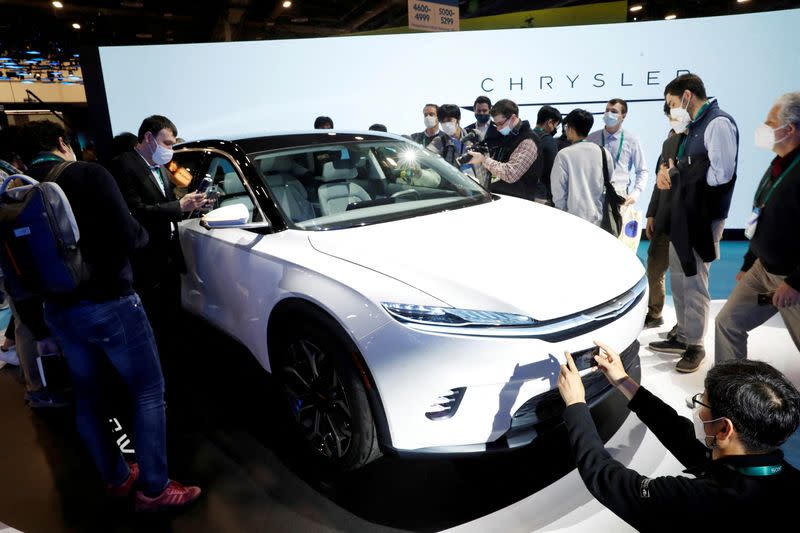Carmaker Stellantis is looking at lower-cost manufacturing markets such as India to make affordable electric vehicles.
Stellantis is investing heavily in EVs and plans to produce dozens of electric models in the coming decade, but its chief executive Carlos Tavares warned recently that it could be five or six years before affordable battery EVs are created.
Tavares spoke at a media roundtable in India late on Wednesday, saying that affordable electric vehicles can’t currently be made in Europe, so he is looking at lower-cost manufacturing in markets such as India.
If India, with its low-cost supplier base, is able to meet the company’s quality and cost targets by the end of 2023, it could open the door to exporting EVs to other markets, the CEO said.
“So far, Europe is unable to make affordable EVs. So the big opportunity for India would be to be able to sell EV compact cars at an affordable price, protecting profitability,” Tavares said.
Stellantis has over a dozen brands such as Alfa Romeo, Chrysler, Citroën, Dodge, DS, Fiat, Jeep, Lancia, Maserati, Opel, Peugeot, Ram and Vauxhall.
ALSO SEE:
China’s Covid Infections Rise Further as Outlook Darkens
Stellantis Eyes India Amid Tension Over China
On his first visit to India since taking over as Stellantis CEO, he said the company is still working out a plan regarding EV exports from the country and had not yet taken any decisions.
Tavares’ possible bet on India comes after American carmakers Ford and General Motors have exited the world’s fourth-largest car market, after failing to make money and break the dominance of Japan’s Suzuki Motor and South Korea’s Hyundai Motor.
It also comes as Chinese EV makers are making inroads into Europe, aiming to win over buyers with more affordable cars having already stolen a march on most foreign rivals in China, the world’s biggest market for EVs.
Stellantis is the latest to refocus its strategy in China where it now plans to be a niche player through its Jeep and Maserati brands, after it said its Jeep joint venture in the country will file for bankruptcy.
“There is a growing tension between China and the Western world. That is going to have a consequence in terms of business. The power that is best placed to leverage this opportunity is obviously India,” Tavares said.
Citroen C3 Set for 2023 India Launch
India, where Stellantis sells its Jeep and Citroen brands, accounts for a fraction of the carmaker’s global sales, but Tavares said the company is not chasing volume and instead wants to ramp up slowly and profitably.
It plans to launch its first EV in the country – an electric model of its Citroen C3 compact car – early next year.
Stellantis already makes its own electric motors and battery packs, and also has plans to make battery cells. In India, too, Tavares wants to locally procure EV components, including batteries so it can be competitive on cost and price.
“EV today is mostly an affordability problem,” he said. “It’s not about technology.”
Mazda $10.6bn EV Plan
In other EV news, Japan’s Mazda Motor Corp this week unveiled a $10.6 billion spending plan to electrify its vehicles and said it was also considering investing in battery production.
The company also raised its sales target for EVs to up to 40% of its total global sales by 2030, as automakers worldwide spend billions to ramp up battery and EV production in the face of tougher environmental regulations.
The investment plan by Mazda follows announcements this year by domestic rivals such as Toyota and Honda, which have been criticised by environmentalists and green activist investors for being slow in electrification.
“We will promote the full-fledged launch of battery EVs and consider investing in battery production. We estimate Mazda’s EV ratio in global sales to rise to a range between 25% and 40% as of 2030,” Mazda said in a statement.
Its previous EV sales target was 25% by 2030.
The new forecast was in line with a broader industry trend, with consulting firm Deloitte expecting EV sales to make up about 32% of total new car sales globally by 2030.
As part of a three-phase plan, Mazda said it would introduce battery-EV models in the “latter half of phase 2” which it identified as between 2025 and 2027. It planned a full-scale launch of full EVs between 2028 and 2030.
Senior managing executive Akira Koga said the 1.5 trillion yen ($10.6 billion) investment would be made with its partners and would be used for research and development.
The automaker said it had agreed to work with seven companies, including electric-component maker Rohm Co, to jointly develop and produce electric drive units.
Executives also said Mazda had reached a supply agreement with battery maker Envision AESC for a limited period between 2025 and 2027.
“Beyond that, we would like to develop a strategy on procurement and securing (batteries) step by step,” said Koga.
Deloitte expects total EV sales to reach 31.1 million by 2030, up from an expected 11.2 million in 2025 and 2.5 million in 2020.
- Reuters with additional editing by Jim Pollard
ALSO SEE:
Australia Set to Impose Incentives for Electric Vehicles – ABC
India Rejects China Car Firm Great Wall’s Bid to Buy GM Plant
























